
Performance management guide
Build 360 feedback into your performance processes
Download to find out how360 Degree Feedback: Process, Examples & Template

360 degree feedback can be an incredibly important tool for performance management. Why? Because it can result in a more holistic, comprehensive and effective review system.
In this article, we break down what it means, offer a handful of sample questions organisations can ask and how you can put your 360 feedback plan in action today.
Take a page out of our book: Our guide to building a great performance management process.What is 360 degree feedback?
The process of 360 degree feedback involves getting feedback on an employee from their colleagues, managers, reports or other stakeholders. Typically, an employee would receive feedback only from their manager. 360 feedback expands that thinking.
The purpose of 360 degree feedback is to make employee evaluations as comprehensive as possible by gathering a variety of perspectives. This provides a more complete picture of individual performance in any given position.
This well-rounded view comes via a collection of stakeholders, including:
Managers: A direct supervisor will assess an employee's performance against set goals, work ethic and contributions to the team.
Peers: Colleagues provide feedback on collaboration, communication and overall effectiveness in working together.
Direct Reports (for managers): When applicable, supervised employees may offer insights into leadership style, communication and effectiveness.
Self-Assessment: The employee themself reflects on their performance, goals achieved and areas for development.
External Stakeholders (optional): Feedback might be solicited from clients, customers or vendors to understand the employee's impact on external relationships.
What is a 360 feedback assessment?
As part of an employee's performance appraisal or evaluation, a 360 feedback assessment typically pulls from multiple sources of feedback to inform an employee's overall performance. This is typically done by a line manager, with the help of HR (if required), but takes multiple stories and pulls them into one coherent professional narrative.
360 degree feedback assessments versus performance reviews
There is a difference between 360 degree feedback and your more traditional performance reviews. While one may be able to feed into the other, it is important to maintain a separate understanding of how they work and the goals they serve.
Here's a quick breakdown to understand the different a bit better:
Feature | Performance review | 360 degree feedback |
|---|---|---|
Perspective | Manager only | Multi-source (manager, peers, reports, self) |
Focus | Goals, tasks, policies | Performance, communication, collaboration, leadership, self-awareness |
Anonymity | No | Yes (optional for manager feedback) |
Frequency | Annual/bi-annual | Can be more frequent |
The chart above illustrates the key difference between a performance review versus 360 degree feedback. Mainly, that feedback is designed to inform reviews which tend to put more value on objective contributions and goals reached.
When you have feedback, you can add colour to any given goal or objective (whether it was hit or not), while gaining a deeper understanding of how someone works and advances their own work within your organisation.
Why is 360 degree feedback important?
360 feedback can be a key strategic tool for organisations when it comes to identifying and developing leaders. Especially in a business that is scaling quickly or in a phase of hypergrowth, 360 feedback is a means to an end when it comes to figuring out how employees collaborate, how they lead projects and how well they get work done with multiple stakeholders.
So, whether as a pillar of growth or succession planning, 360 feedback can serve the purpose of helping identify if an employee is growing in their role and if they are a candidate for leadership down the road.
In addition to that, it’s hard to ignore the kind of trickle-down effect that implementing a 360 feedback program can have on your type of company culture. Implementing a large-scale feedback process, one that loops in the entire company, may drive a culture of feedback (for better or worse, depending on how well your employees are prepared to take feedback).
Benefits of 360 degree feedback
There’s a lot of work involved in getting a 360 feedback program off the ground, so is it worth it? If you’re looking to divorce yourself from the typical manager-employee feedback process, but not sure if it’s worth the time involved, here are some of the benefits of launching 360 feedback within your organisation:
Objectivity – When you extend feedback to multiple stakeholders, and not just one, you’ll more get more unbiased, objective, and therefore usable feedback.
Accuracy – If you loop in varying stakeholders, especially those who have worked intimately on a project or on a day-to-day basis with an employee, you’ll gain a more accurate picture of their success.
Engagement – Employees want to feel included, and that definitely extends to leaving feedback. Whether to praise or to help an employee learn, 360 feedback can have an effect on how you measure employee engagement.
Development – When an employee knows they are getting feedback from multiple sources, and don’t see the process as biased, they are more likely to take the learnings of the feedback process and implement them in their working life.
Drawbacks of 360 feedback
Some of the key drawbacks of 360 feedback include:
Effort – It takes a lot of work to get a 360 feedback program off the ground, especially in larger organisations. For that reason, it can be quite time-consuming — which is why having an HR software to cover all your other tasks and reminders definitely helps.
Anonymity – Keeping employees anonymous can be a bit of a double-edged sword. It can help employees express their opinions freely, but it can also lead to them being more empowered to be hyperbolic or make grand, sweeping statements that don’t help employees deliver.
While these drawbacks do exist, it’s not like there’s nothing we can do about them.
Introduce 360 degree feedback into your organisation with Personio

Personio's all-in-one HR software offers a 360 degree feedback feature for continuous feedback. Employees are empowered to request feedback, give feedback and managers can even ask for feedback as part of performance cycles. Learn more today.
Show me how it worksShould 360 degree feedback be anonymous?
In almost every case, yes. If you want more honest responses from stakeholders, then you should make 360 feedback anonymous. That said, you can leave room for respondents to choose to leave a named response (if they feel it would be instructive to the person receiving the feedback). That said, this should remain only an option.
Implementing a 360 feedback assessment process
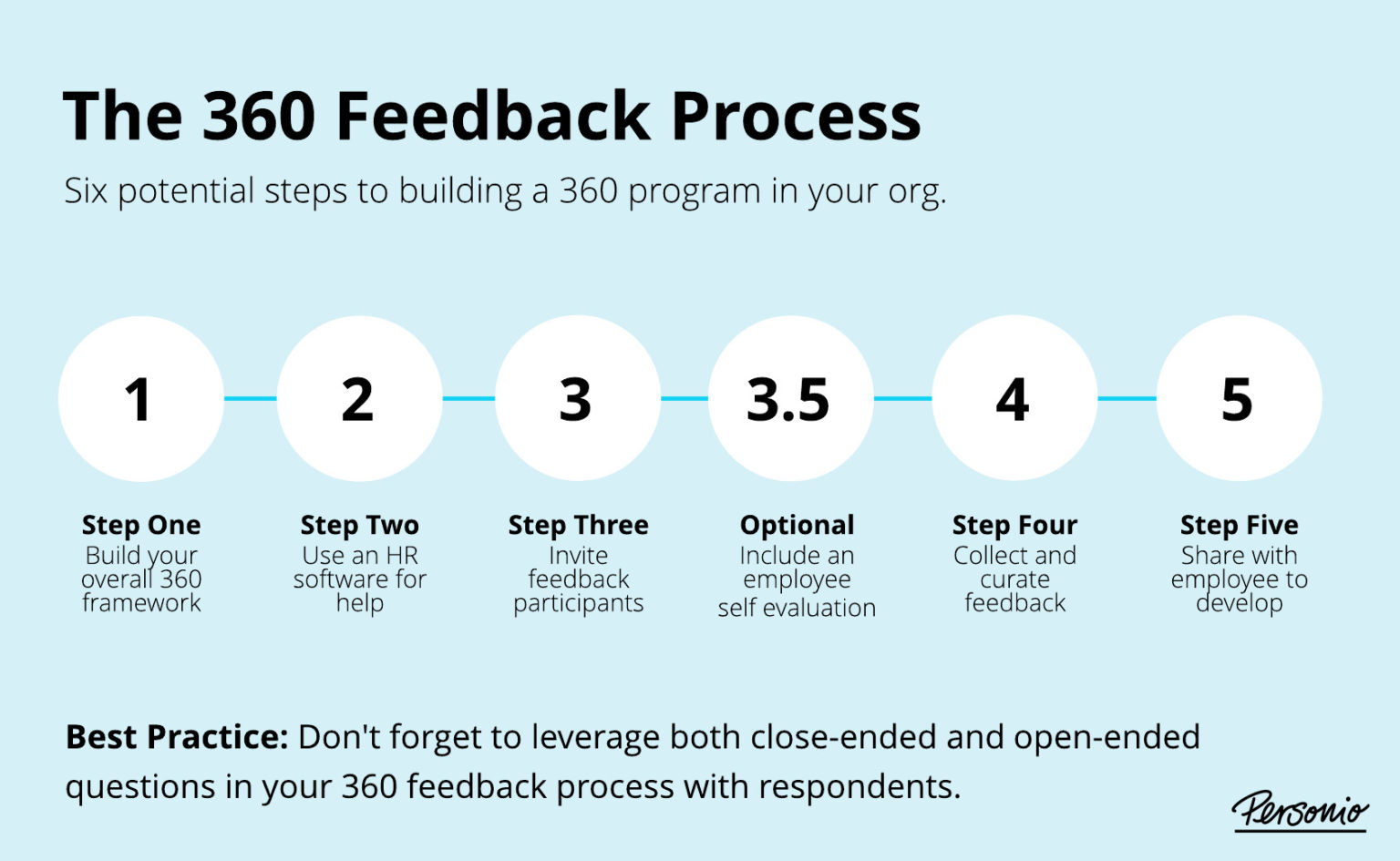
If you’re sold on 360 at this point and want to get started, let’s kick things off with the full breakdown of how you should go about building your program:
Step one: Build your 360 feedback framework
The first step is to define how 360 feedback is going to work within your organisation. This would include defining eligibility criteria, the rollout process, the necessary documentation and how you will evangelise it to your teams.
One of the biggest things to focus on here is the process of actually giving feedback. You may need to start by running company-wide training sessions on how to give feedback appropriately to ensure consistency across your organisation.
After that, consider how you want 360 feedback to form your performance review process. Does it need to be mandatory? How many pieces of feedback should be included? Do you want to loop in external or customer voices? All important questions to consider.
Step two: Build a feedback module

Once you have a philosophy in place, you need to figure out a way to make feedback more accessible to your organisation. After all, if it's not easy to give feedback (and document it accordingly), adoption in your workforce will lag.
Gaining access to an HR software that can request, give and store feedback is table stakes for today's modern organisation. Additionally, the ability to then incorporate feedback into performance review processes is also critical.
In a perfect world, your HR software should be able to automate a lot of these processes. This way, your HR team can instead focus on training people on giving feedback or coaching your managers to host most impactful performance conversations.
Step three: Set goals for the 360 assessment

If you want your 360 feedback process to be a success, you need to have goals that can serve as a North Star for your organisation. The main thing is to ensure that feedback is progressing toward overall positive development for your employees.
Think about how this is going to come out in your metrics. After deploying a 360 process, consider tracking some of the following:
Overall performance ratings
Rates of feedback collected and adoption
Career progression and promotion rates
Attrition and regretted churn rates
When you have a set of KPIs that are mapped toward your goals, this can help ensure that your 360 feedback programme is living up to it.
Streamline your employee development

Define performance cycles, set goals, give effective feedback and evaluate performance fairly. Put structure on how you grow and retain staff with powerful performance management.
Boost your performanceStep four: Invite stakeholders to give feedback
Now, it's time to get operational. Once you have your programme, a solution and your goals in place, we can start rolling out the 360 feedback process across your organisation.
Take the time to invite colleagues, managers, senior leaders and other stakeholders to answer questions regarding that employee’s performance (more on those questions later).
Make sure to spend time championing the importance of feedback for your workforce and making it clear why it matters for people to participate.
Optional step: Employees complete self-evaluation
This is an optional step, but one that many organisations promote. Have your employee complete their own self-evaluation, and treat them as key stakeholders in the overall 360 feedback process. Their voice matters, so work them into the process.
Step five: Collect feedback
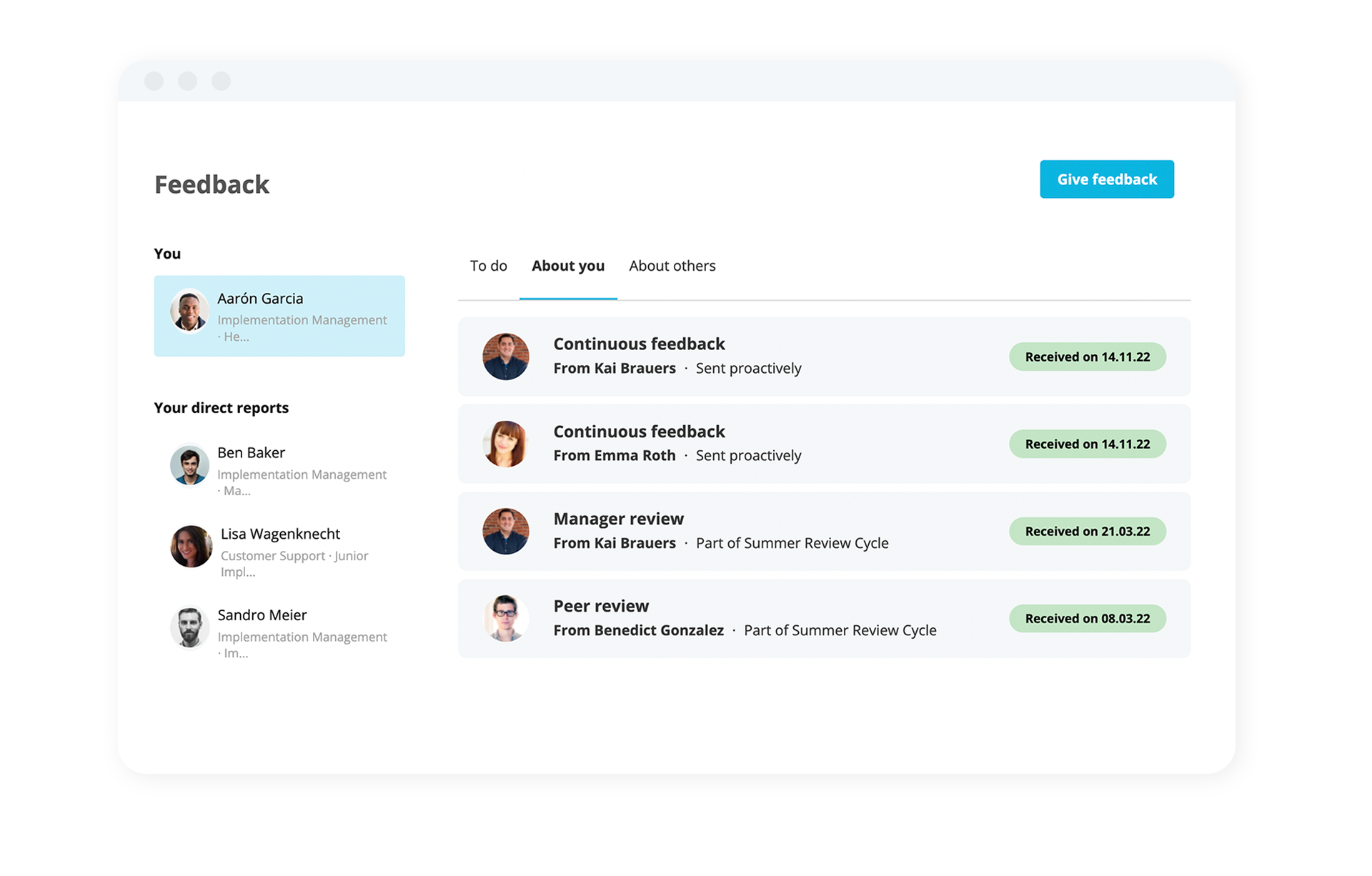
Collect all of the feedback, share it with the employee’s manager, and find a way to package it in a way that will make sense for the employee. Offer a tailored, summarised version that leaves out specifics that single out respondents.
The major point here is to index on helping your managers collect and collate feedback from numerous sources. Help them learn how to write more impactful reviews, ones that incorporate feedback and focus on next steps for employees.
Feedback is only meaningful when it is actionable. For your collection efforts to be successful, managers need to know what to do with collected feedback.
Step six: Share feedback
Share with the employee the feedback and work with them to define action steps that can help them develop in their role. In addition, be sure to thank those who weighed in.
The most important part here is to focus on next steps. What can employees do with feedback, and how do you ensure they action it?
This is especially true if your teams encounter any red flags in the feedback phase. If you see anything troublesome, you need to have some kind of system in place that hinges on accountability and ensures that employees are learning from feedback received.
360 feedback questions: examples and template
Earlier, we covered the two key types of 360 feedback questions: closed-ended and open-ended. But, how do these questions look in practice, and what questions get the most meaningful results?
First, let’s talk about the merits of each type of question:
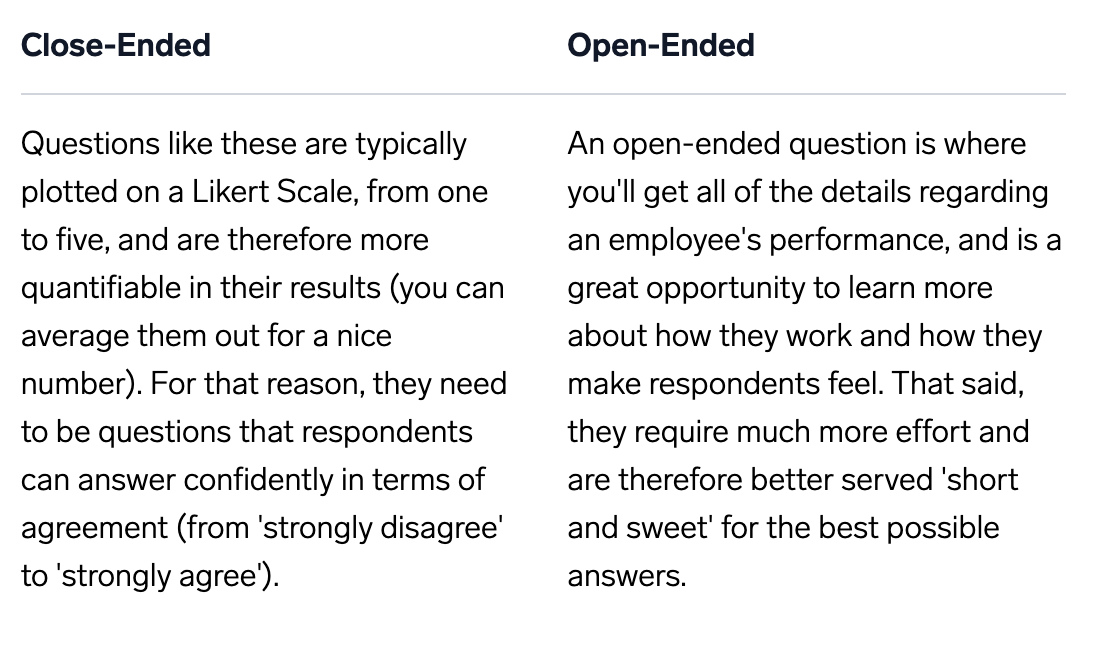
Closed-ended questions
Here are some examples of popular closed-ended questions you can ask:
This employee meets their deadlines and works in an efficient manner
This employee brings a good attitude into their work and works with others.
This employee is clear in how they communicate with other team members.
This employee offers creative problem-solving in the face of potential issues.
This employee embodies your company culture or values.
This employee is often focused on the task at hand and completing projects.
This employee is transparent in their approach and communicates decisions.
This employee completes their work to a high standard with great diligence.
This employee would be described as a role model in your organisation.
This employee always keeps the needs of the customer/target audience top of mind.
Open-ended questions
Here are some examples of popular open-ended questions you can ask:
What kind of role has this employee taken when working on projects together?
What is one thing this employee should start doing in their role?
What should this employee continue doing in their role that works well?
What should this employee stop doing that isn’t working for them?
How has this employee lived your company’s culture or values?
How does this employee handle taking feedback and putting it into practice?
Does this employee approach their work with diligence and attention to detail?
How has your communication been with this employee on projects?
Where do you think this employee could improve in your working relationship?
How could you see this employee taking the next step in their development
360 surveys for 360 feedback
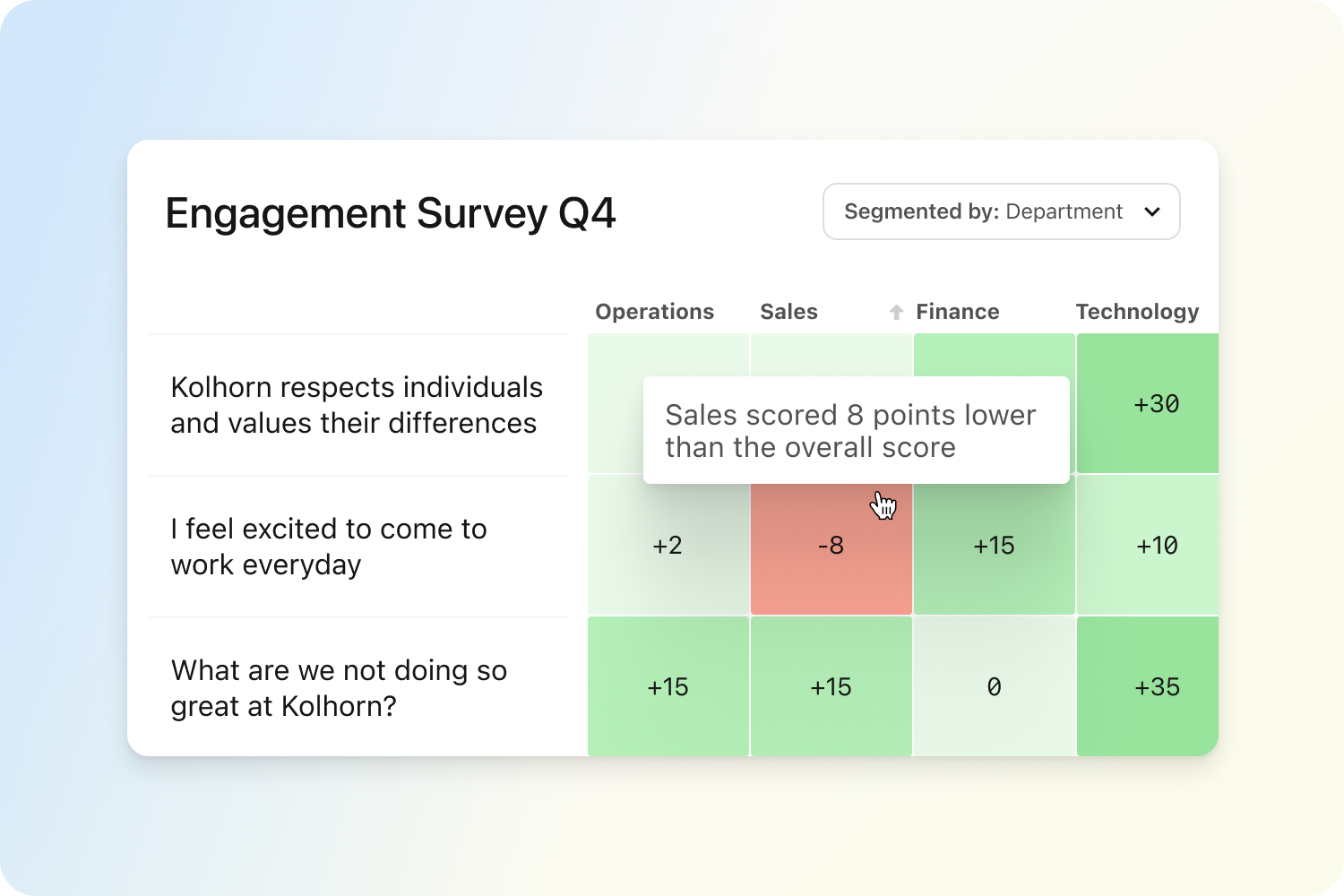
To collect 360-degree feedback, well-designed surveys are essential.
First, determine who will provide feedback (managers, peers, etc.) Then, craft clear and concise questions targeting areas like communication and collaboration. Consider offering anonymity for honest responses. Pilot test the survey and refine it based on feedback.
Using dedicated software like Personio can streamline the process. Personio easily allows for building custom surveys, managing participants and collecting anonymised feedback for analysis.
360 feedback best practices
There are two best practices that are absolutely essential to the success of any 360 feedback program:
Coaching your respondents
Promoting transparency across your organisation
The first should be a bit obvious. Not only do you want people to respond in a timely fashion, but you want them to leave the best possible answers while also enjoying the process.
So, your organisation should not only share what your new process looks like but should hold informal sessions as to how to leave amazing feedback that is actionable for employees. Feedback is an art form, so you need to coach potential respondents to succeed in the process.
This feeds into the second point: transparency. The last thing you want is for the introduction of your new feedback program to seem like a disciplinary measure or something to be feared. This is where your HR team comes into the mix.
Share with your entire organisation, ideally, during an all-team meeting where everyone is present, the purpose of the 360 feedback process, how you have built it, and which considerations you made along the way.
When you do this, employees will come to understand why the program exists, and they will leave feedback that speaks to those core principles. In short, everybody wins because everyone is on the same page!
360 degree feedback with Personio
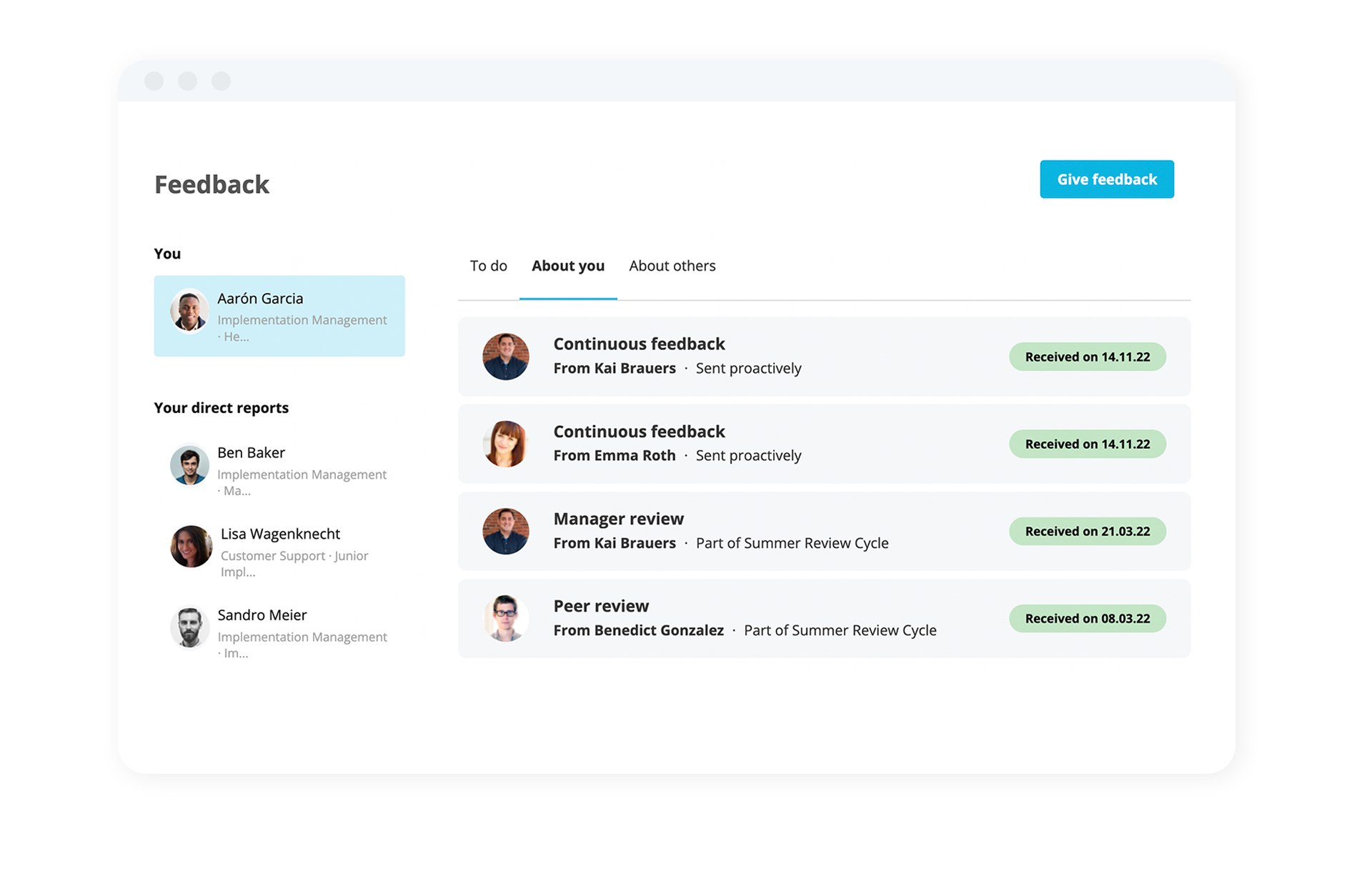
Within Personio, employees can share feedback, request feedback and managers can request feedback as part of an employee's performance cycle. Cycles that can be fully automated to run without the need for manual work and maintenance.
If feedback matters to your organisation, and you want to instil a culture of continuous feedback, we'd recommend getting to know a bit more about Personio's performance management software. Or, chat with one of our experts today.
